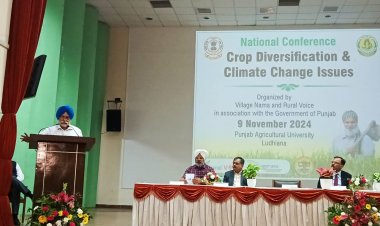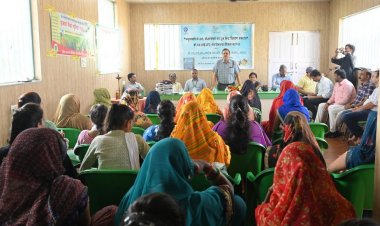Commercial release of Indian mustard genetically modified for herbicide tolerance authorized in Australia
Australia's gene technology regulator Office of Gene Technology Regulator (OGTR) has released the commercial cultivation of Indian mustard genetically modified for herbicide tolerance (HT) — GM Indian mustard. On 19 October 2022, the Government of Australia made public the OGTR’s decision to issue the licence. According to it, the multinational company (MNC) BASF Australia Ltd has been given the licence for the commercial release of GM Indian mustard.

While the Government of India is yet to take a decision regarding the genetically modified (GM) variety of mustard, Australia's gene technology regulator Office of Gene Technology Regulator (OGTR) has released the commercial cultivation of Indian mustard genetically modified for herbicide tolerance (HT) — GM Indian mustard. On 19 October 2022, the Government of Australia made public the OGTR’s decision to issue the licence. According to it, the multinational company (MNC) BASF Australia Ltd has been given the licence for the commercial release of GM Indian mustard. The gene technology regulator has issued Licence No. DIR 190 to BASF Australia that authorises it to commercially release Indian mustard genetically modified for herbicide tolerance.
In fact, India is the origin of the mustard plant. It is therefore known as Indian mustard. This is the first genetically modified Indian mustard to be approved for commercial cultivation anywhere in the world. The released Indian mustard species goes by the name Brassica juncea. Its herbicide-tolerant variety based on male fertility restoration technique has been granted the licence. Developed by BASF Australia, the GM variety of Indian mustard has been genetically modified through line RF3 event ACS-BN003-6 and imparted tolerance to herbicide Glufosinate Ammonium. That is, if Glufosinate Ammonium is sprayed to control grasses and broadleaf weeds in this crop variety, the crop will not suffer any loss. GM Indian mustard variety RF3 contains the bar and barstar genes. It has been developed by crossing non-GM Indian mustard with GM canola, already approved and cultivated successfully on large scale in Australia since 2003.
The speciality of mustard oil is its pungency, which is not found in other edible oils. Even canola, which is counted as a member of the genetic family of mustard, misses this characteristic. It is this characteristic that is responsible for the high consumption of mustard oil in India as well as in other countries. Given this fact, the commercial release in Australia of the GM Indian mustard variety genetically modified for herbicide tolerance implies that Australia may corner a huge market share of mustard oil in the days to come. The possibility of the Indian market being part of this cannot be ruled out.
The licence says that the company is authorized to release this variety throughout Australia. The GM Indian mustard and products derived from it may enter general commerce, including use in human food and animal feed. The licence decision was informed by a Risk Assessment and Risk Management Plan (RARMP) undertaken by the OGTR with input from stakeholders nationwide. This included consultation with the public, state and territory governments, local councils, Australian Government agencies, the Minister for the Environment and the Gene Technology Advisory Committee. Issues were raised relating to risks to human health and safety and the environment. The RARMP concluded that this commercial release posed a negligible risk to people and the environment. General licence conditions have been imposed to ensure ongoing oversight of the release.
This licence authorises BASF Australia to commercially release Indian mustard genetically modified for herbicide tolerance. The GM Indian mustard is allowed to be grown in all Indian-mustard-growing areas in Australia, subject to restrictions in some Australian States and Territories for marketing reasons. Commercial Indian mustard production occurs on a small scale, mainly in central New South Wales and western Victoria.
South Asia Biotechnology Centre founder-director Dr Bhagirath Choudhary said to Rural Voice that in the past, the GM varieties of canola (Brassica napus), a temperate species of mustard, had been granted approval. Its GM varieties genetically modified for herbicide with multiple modes of action and pollination control have been cultivated since 1996 in many canola-growing countries, including Canada, USA and Australia.
According to Dr Choudhary, canola edible oil is traded on a large scale in the international market. India, too, imports about five lakh tonnes of canola oil, which is derived from GM canola. Besides, a large part of soyabean oil, which India imports, is derived from GM soyabean.
The GM mustard variety has been developed in India but its commercial release is yet to be approved. Dr Deepak Pental, the ex-Vice Chancellor of the University of Delhi, had developed Dhara Mustard Hybrid-11, otherwise known as DMH-11, a genetically modified hybrid variety of mustard. The Genetic Engineering Appraisal Committee (GEAC) appointed a committee to submit its report on the commercial release of this variety. Rural Voice did a detailed story in this regard on October 17 that may be accessed on the link given below.
According to the information obtained by Rural Voice, a GEAC meeting was scheduled to be held recently to decide on the recommendations of the sub-committee. However, no information has been released in this regard so far.



 Join the RuralVoice whatsapp group
Join the RuralVoice whatsapp group









































